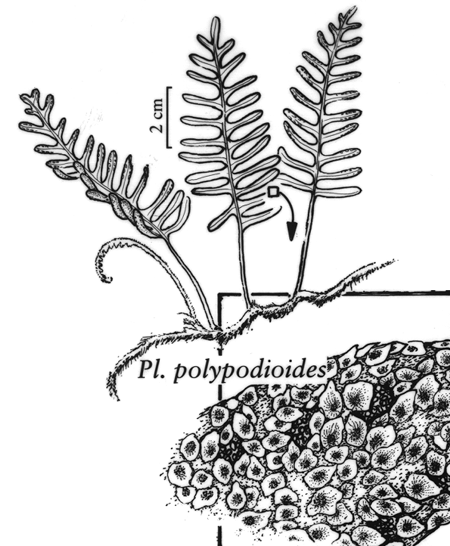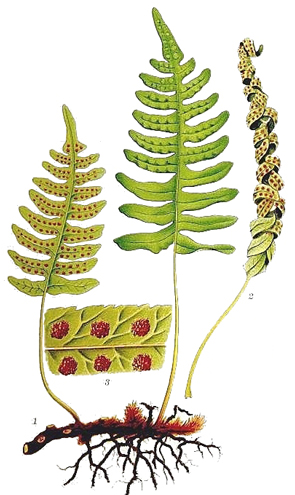|
Hardy Fern Home All Ferns Fern Families ��Aspleniaceae ��Blechnaceae ��Dennstaedtiaceae ��Dryopteridaceae ��Lygodiaceae ��Osmundaceae ��Polypodiaceae ��Pteridaceae ��Thelypteridaceae ��Woodsiaceae Fern Genera ��Adiantum ��Arachniodes ��Aspidotis ��Asplenium ��Astrolepis ��Athyrium ��Blechnum ��Cheilanthes ��Cryptogramma ��Cyrtomium ��Cystopteris ��Dennstaedtia ��Deparia ��Diplazium ��Dryopteris ��Gymnocarpium ��Lygodium ��Matteuccia ��Onoclea ��Oreopteris ��Osmunda ��Pellaea ��Phegopteris ��Pleopeltis ��Polypodium ��Polystichum ��Pteridium ��Pteris ��Pyrrosia ��Thelypteris ��Woodsia ��Woodwardia |
| Polypodiaceae | ||
|
Petiole usually jointed at base, blade simple to pinnate, indusia absent, spores usually transparent or yellowish. Here 3
genera. | ||
| Pleopeltis | ||
Scaly polypods, Shielded-sorus ferns | ||
|
Etymology
pleos, many, and pelte, shield, in reference to the peltate scales covering immature sori
Description
Rhizome: creeping, branching, scales concolored to bicolored, lanceolate to ovate-acuminate, not clathrate to strongly clathrate.
Frond: evergreen, monomorphic. Stipe: jointed at base, green to dark brown or black, flattened to terete, often grooved below and winged above, scaly or not, vascular bundles: 3. Blade: pinnatifid, broadly ovate to deltate, leathery. segments linear to oblong, margins entire to serrate, veins free or netted. Sori: circular to oval, discrete, borne at tips of single veins, in 1-3 rows on either side of midrib, often confined to distal region of leaf, indusium: absent, sporangia: transparent or yellowish.
Distinctive Characteristics
pinnatifid, leathery blade, long-creeping rhizome, fronds jointed to the rhizome, and young sori covered by peltate scales. Epiphytic, sometimes on rocks, rarely terrestrial, mostly tropical.
|
|
|
| Polypodium | ||
Polypody | ||
|
Etymology
Polypodium is from the Greek: polys, many, + podion, foot. The branching rhizome and its roots appear many-footed. Others think it refers to the many stipe bases on the upper side of the stem.
Description
Rhizome: creeping, branching, scales concolored to bicolored, lanceolate to ovate-acuminate, not clathrate to strongly clathrate.
Frond: evergreen, monomorphic. Stipe: jointed at base, straw-colored, scaly or not, vascular bundles: 3. Blade: pinnatifid, broadly ovate to deltate, leathery. segments linear to oblong, margins entire to serrate, veins free or netted. Sori: circular to oval, discrete, borne at tips of single veins, in 1-3 rows on either side of midrib, often confined to distal region of leaf, indusium: absent, sporangia: transparent or yellowish.
Distinctive Characteristics
pinnatifid, leathery blade, long-creeping rhizome, fronds jointed to the rhizome, and the naked sori.
Compare species in the Eastern Asia Group
Compare species in the Eastern North America Group
Compare species in the Western North America Group
Compare species in the European Group
|
|
|
| Pyrrosia | ||
Felt fern | ||
|
Etymology
From the Greek pyrros, flame-coloured, in reference to the reddish lamina scales of some species
Description
Rhizome: creeping, with phylopodia, scaly.
Frond: evergreen, monomorphic or nearly so. vascular bundles: . Blade: simple or pedate, ovate often, leathery or papery, stellate scales. veins netted. Sori: round or oblong, ends of veins, indusium: absent, sporangia: yellow to brown at maturity.
Distinctive Characteristics
epiphytic or epipetric, stellate hairs on the lamina
|
|
|

